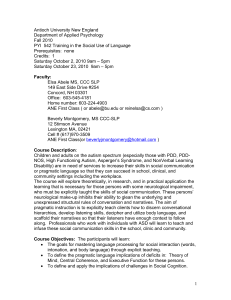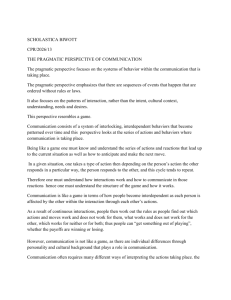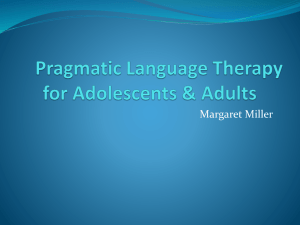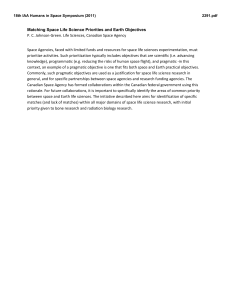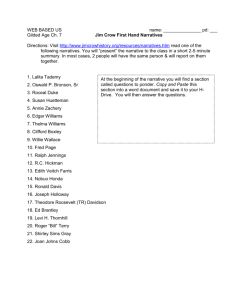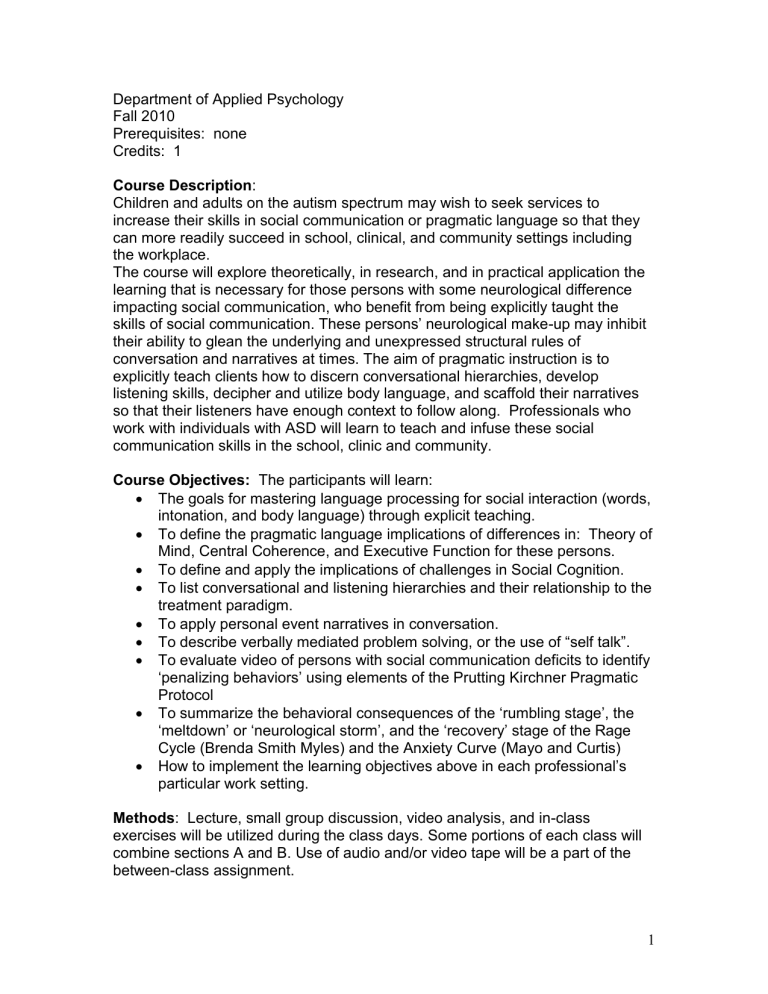
Department of Applied Psychology Fall 2010 Prerequisites: none Credits: 1 Course Description: Children and adults on the autism spectrum may wish to seek services to increase their skills in social communication or pragmatic language so that they can more readily succeed in school, clinical, and community settings including the workplace. The course will explore theoretically, in research, and in practical application the learning that is necessary for those persons with some neurological difference impacting social communication, who benefit from being explicitly taught the skills of social communication. These persons’ neurological make-up may inhibit their ability to glean the underlying and unexpressed structural rules of conversation and narratives at times. The aim of pragmatic instruction is to explicitly teach clients how to discern conversational hierarchies, develop listening skills, decipher and utilize body language, and scaffold their narratives so that their listeners have enough context to follow along. Professionals who work with individuals with ASD will learn to teach and infuse these social communication skills in the school, clinic and community. Course Objectives: The participants will learn: The goals for mastering language processing for social interaction (words, intonation, and body language) through explicit teaching. To define the pragmatic language implications of differences in: Theory of Mind, Central Coherence, and Executive Function for these persons. To define and apply the implications of challenges in Social Cognition. To list conversational and listening hierarchies and their relationship to the treatment paradigm. To apply personal event narratives in conversation. To describe verbally mediated problem solving, or the use of “self talk”. To evaluate video of persons with social communication deficits to identify ‘penalizing behaviors’ using elements of the Prutting Kirchner Pragmatic Protocol To summarize the behavioral consequences of the ‘rumbling stage’, the ‘meltdown’ or ‘neurological storm’, and the ‘recovery’ stage of the Rage Cycle (Brenda Smith Myles) and the Anxiety Curve (Mayo and Curtis) How to implement the learning objectives above in each professional’s particular work setting. Methods: Lecture, small group discussion, video analysis, and in-class exercises will be utilized during the class days. Some portions of each class will combine sections A and B. Use of audio and/or video tape will be a part of the between-class assignment. 1 Evaluation Methods: Class members are expected to have read the background material for each class session and to be able to discuss it at a graduate level of competence. Class members are further required to apply the theoretical and research material to specific examples in their own experience working with this population in both oral discussion and written form. The written assignment, to be completed between October 2 and October 23, is due on or before October 23, and each student will be expected to present it to the class. Your grade will be a combination of your level of class participation and your assignment. Remember: Plagiarism is unethical and grounds for course failure. Students who have documented disabilities or other individual needs should contact the professor prior to assignment due dates with any requests for special accommodation. According to Graduate School policy, students missing class must see the instructor to arrange alternative learning. In this course learning is very dependent on in-class participation and it is strongly recommended that no class sessions be missed if possible. Students are expected to notify the professor prior to class time if they are unable to attend. A class can be made up by attending the same class offered in the next fall first semester of the certificate program. Course Outline: October 2, 2010: Developing Pragmatic Language Skills for Social Communication I. Theoretical Foundations for Social Interaction A. Theory of Mind (read B&W chapter 2 pp.11-42 and Winner, 2002) B. Central Coherence C. Executive Function D. Social Cognition . II. Practical Techniques, Strategies and Tools for Processing Social Language A. The Hidden Curriculum B. Essential Skills for Social Success C. Classroom Infusion and Participation D. Transition III. Assessment of Strengths and Penalizing Behaviors (read Bishop , pp809-818) A. Use of Checklists, (read Bishop pp.809-818 and Prutting Kirshner pp.105-119 ) 2 IV. B. Video analysis C. Evaluation Protocol Class Assignment October 23, 2010: Using Language to Build Social Skills I. Treatment Groups: Referenced to Scope and Sequence. (read Chapter 11 Baker and Welkowitz) A. Criteria for Group Formation B. Goal Setting 1. Conversational Hierarchy and Listening Hierarchy, (read Hoskins, pp.3-29.) 2. Personal Event and Procedural Narratives . 3. “Self Talk” Verbally Mediating Problem Solving 4. Self Regulation C. Organization and Content II. Stations for Hands-on Guided Practice (read Winner 2000) III. Presentation of Assignments Assignment: You are to turn in a 1-3 page paper which will: 1. Define in your own words the concepts of: Theory of Mind Central Coherence Executive Functioning Social Cognition 2. Tape record or videotape a person or group on the spectrum and transcribe one to two minutes of the conversation that exemplifies challenges they have in the above concepts. (If you do not have anyone on the spectrum to record, use a neurotypical person and describe how they do use these concepts that are skills they have.) 3. Provide a conclusion that relates the transcription to the concepts above. Describe in a few sentences what you might design to teach the skills that are challenges. Conclude with several sentences that describe your plan for generalization of the skills long term. Note: We will discuss securing permission to record and confidentiality issues in class. 3
